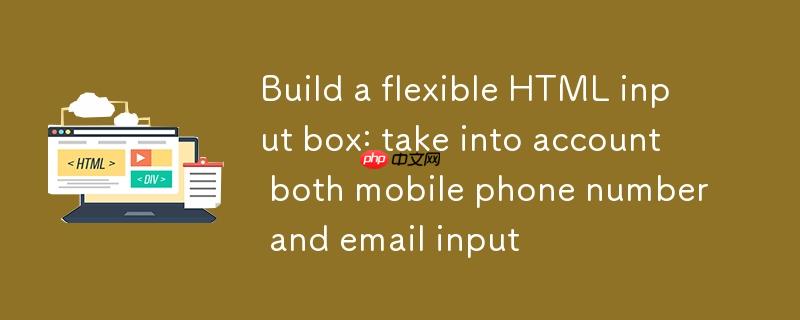
在HTML中,创建一个能够接受多种类型输入的字段,最直接的方法是使用通用的文本输入框 <input type="text">。为了明确告知用户该字段可以输入手机号或邮箱,我们可以利用 placeholder 属性提供一个提示文本。
placeholder 属性会在输入框为空时显示一段描述性文字,当用户开始输入时,该文字会自动消失。这对于引导用户理解输入框的预期内容至关重要。
示例代码:
<input type="text" id="contactInput" name="contact" placeholder="请输入手机号或邮箱">
在这个例子中:
立即学习“前端免费学习笔记(深入)”;
虽然 placeholder 提供了初步的用户指导,但一个字段同时接受两种不同格式的数据,在实际应用中会带来一些挑战:
用户体验最佳实践建议:
当必须使用一个字段接收两种类型输入时,JavaScript是实现客户端验证的关键。我们可以通过正则表达式 (RegEx) 来判断用户输入的内容是邮箱地址还是手机号码。
核心思路:
示例代码:
<!DOCTYPE html>
<html lang="zh-CN">
<head>
<meta charset="UTF-8">
<meta name="viewport" content="width=device-width, initial-scale=1.0">
<title>灵活输入框示例</title>
<style>
body { font-family: Arial, sans-serif; margin: 20px; }
.input-group { margin-bottom: 15px; }
label { display: block; margin-bottom: 5px; font-weight: bold; }
input[type="text"] {
width: 300px;
padding: 8px;
border: 1px solid #ccc;
border-radius: 4px;
font-size: 16px;
}
.message {
margin-top: 10px;
padding: 8px;
border-radius: 4px;
display: none; /* 默认隐藏 */
}
.message.success { background-color: #d4edda; color: #155724; border-color: #c3e6cb; display: block; }
.message.error { background-color: #f8d7da; color: #721c24; border-color: #f5c6cb; display: block; }
</style>
</head>
<body>
<h1>注册/登录</h1>
<div class="input-group">
<label for="contactInput">联系方式:</label>
<input type="text" id="contactInput" name="contact" placeholder="请输入手机号或邮箱" oninput="validateContact()">
<div id="validationMessage" class="message"></div>
</div>
<script>
function validateContact() {
const inputField = document.getElementById('contactInput');
const messageDiv = document.getElementById('validationMessage');
const inputValue = inputField.value.trim(); // 获取输入值并去除首尾空格
// 清除之前的消息
messageDiv.className = 'message';
messageDiv.textContent = '';
if (inputValue === '') {
// 输入为空,不显示错误,但也不显示成功
return;
}
// 手机号正则表达式 (中国大陆手机号,仅供示例,实际可能需要更严谨)
const phoneRegex = /^1[3-9]\d{9}$/;
// 邮箱正则表达式 (通用邮箱格式)
const emailRegex = /^[a-zA-Z0-9._%+-]+@[a-zA-Z0-9.-]+\.[a-zA-Z]{2,}$/;
if (phoneRegex.test(inputValue)) {
messageDiv.classList.add('success');
messageDiv.textContent = '输入格式为:手机号';
// 可以在这里进一步处理手机号逻辑
} else if (emailRegex.test(inputValue)) {
messageDiv.classList.add('success');
messageDiv.textContent = '输入格式为:邮箱';
// 可以在这里进一步处理邮箱逻辑
} else {
messageDiv.classList.add('error');
messageDiv.textContent = '请输入有效的手机号或邮箱地址。';
}
}
</script>
</body>
</html>代码解析:
注意事项:
动态 type 属性: 可以尝试根据用户输入的前几个字符动态修改 input 元素的 type 属性。例如,如果输入以数字开头,可以将其 type 设为 tel;如果包含 @ 符号,则设为 email。但这会增加代码复杂性,且可能与浏览器自动填充行为产生冲突。
// 示例:动态改变type属性 (仅作演示,实际应用需谨慎)
function dynamicTypeChange() {
const inputField = document.getElementById('contactInput');
const inputValue = inputField.value;
if (inputValue.includes('@')) {
inputField.type = 'email';
} else if (/^\d+$/.test(inputValue)) { // 如果全是数字
inputField.type = 'tel';
} else {
inputField.type = 'text'; // 恢复默认
}
}
// 在 oninput 事件中调用此函数autocomplete 属性: 对于 type="text" 的输入框,可以尝试使用 autocomplete 属性来提供一些提示,例如 autocomplete="off" 来禁用自动填充,或者 autocomplete="username" 等。但对于“手机号或邮箱”这种混合场景,没有一个 autocomplete 值能完美覆盖。
国际化 (i18n): 如果你的应用面向全球用户,手机号的格式会因国家而异,需要更复杂的验证逻辑和可能的用户国家/地区选择。
创建一个能够灵活接受手机号或邮箱的HTML输入框,核心在于平衡用户体验和技术实现。虽然一个简单的 <input type="text" placeholder="..."> 可以满足基本需求,但为了提供更佳的用户体验和确保数据有效性,结合JavaScript进行客户端验证是不可或缺的。同时,开发者应始终牢记,客户端验证仅为辅助,服务器端验证才是保障数据安全和业务逻辑严谨性的最终防线。在设计时,优先考虑用户清晰度和易用性,有时甚至可以选择提供分离的输入字段,以简化用户操作和开发维护成本。
以上就是构建灵活的HTML输入框:兼顾手机号与邮箱输入的详细内容,更多请关注php中文网其它相关文章!

HTML怎么学习?HTML怎么入门?HTML在哪学?HTML怎么学才快?不用担心,这里为大家提供了HTML速学教程(入门课程),有需要的小伙伴保存下载就能学习啦!

Copyright 2014-2025 https://www.php.cn/ All Rights Reserved | php.cn | 湘ICP备2023035733号